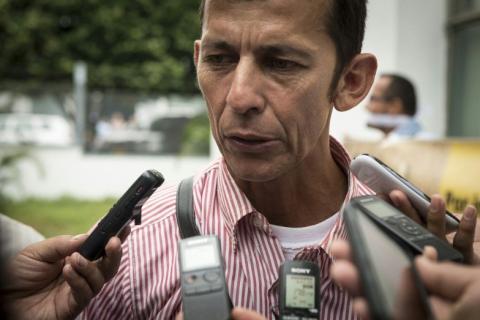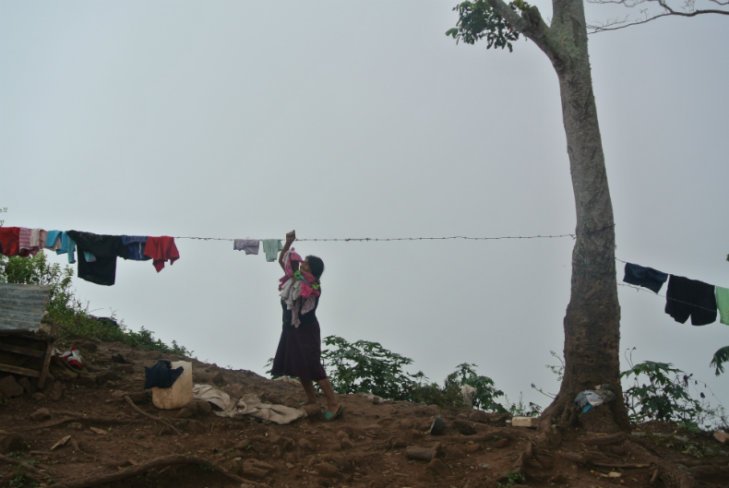
by Deep Green Resistance News Service | Jan 24, 2017 | Colonialism & Conquest, Indigenous Autonomy
Featured image: A Yukpa woman tends laundry high in the clouds of the Yukpa lands, which rise over 3000 meters in the Sierra Perijá on the border of Colombia and Venezuela.
by Nicholas Parkinson / Intercontinental Cry
A community of indigenous Yukpa saw their land reduced to a third of what it once was due to violence and intimidation. Now Colombia’s Land Restitution Unit is helping the community return to their lands.
The spiritual equilibrium essential to the Yukpa community is off balance. Ancestral burial grounds have been desecrated by invaders; the trees that house the spirits are being cut down; and the wild game that Yukpa men once hunted with zeal is no longer available. The same limitations preventing the community from practicing its culture are preventing Yukpa parents from passing these activities, words, and stories down to new generations.
“The loss of culture is very real. Our children won’t know anything about the Yukpa if we aren’t rescued from extinction. If we don’t have space to preserve our culture, I guarantee that in thirty years, our culture will disappear,” says Andrés Vence, council leader of a Yukpa community consisting of 120 families living on 300 hectares in the Sierra Perijá on the border of Venezuela and Colombia.
“Culture’s longevity depends on territory.”
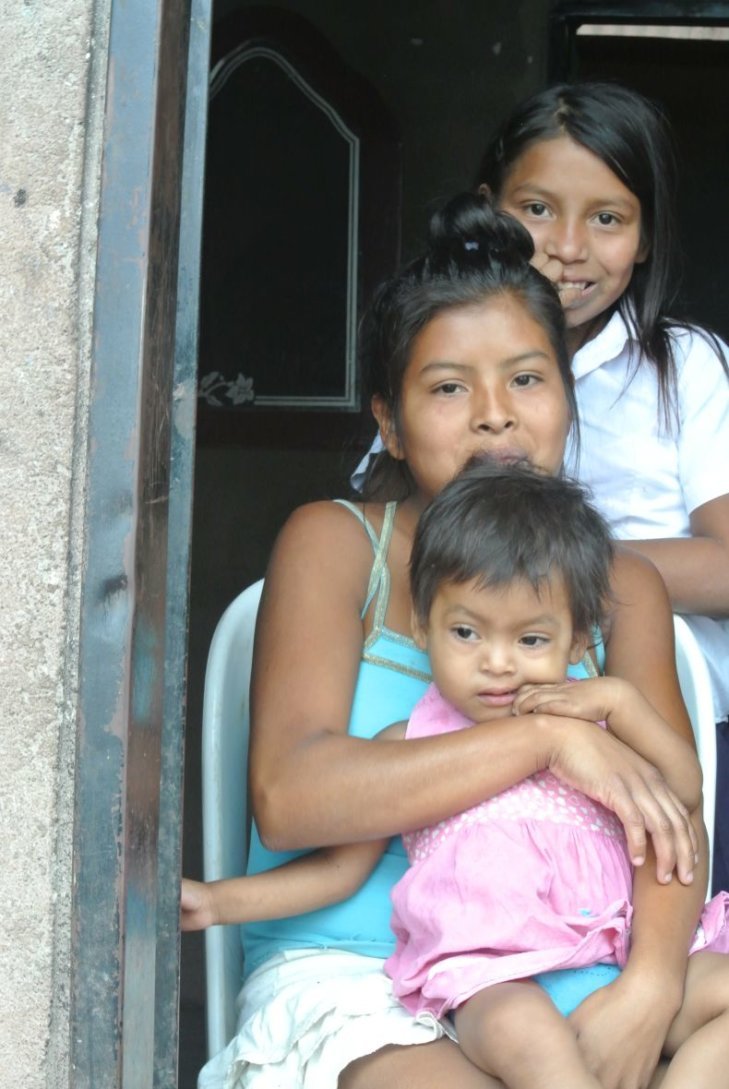
The yukpa believe that land is the key to allowing their culture, customs and beliefs to flourish.
There are an estimated 6,000 Yukpa remaining in Colombia, and the majority live on autonomous lands known as resguardos. Over the past thirty years, the Yukpa community living in La Laguna has been victim to abuse and intimidation stemming from the armed conflict. The community has also seen its ancestral lands become increasingly occupied by “outsiders,” whom they refer to as colonists. Now, the community is pushing back by launching an ethnic restitution claim that seeks to recover 964 hectares of land and allow the community the space it needs to flourish.
HUMILIATION AND ABUSE
In 1982, the guerrilla group known as the FARC came to Yukpa territory to recruit. Andrés Vence was abducted for eight days to be indoctrinated. He and the Yukpa resisted, but then another guerrilla group known as ELN arrived the following year. After the ELN abducted several young men, Vence and his men–armed with just bows and arrows–marched into the guerrilla camp and took their children back, saying the Yukpa would not participate in any war.
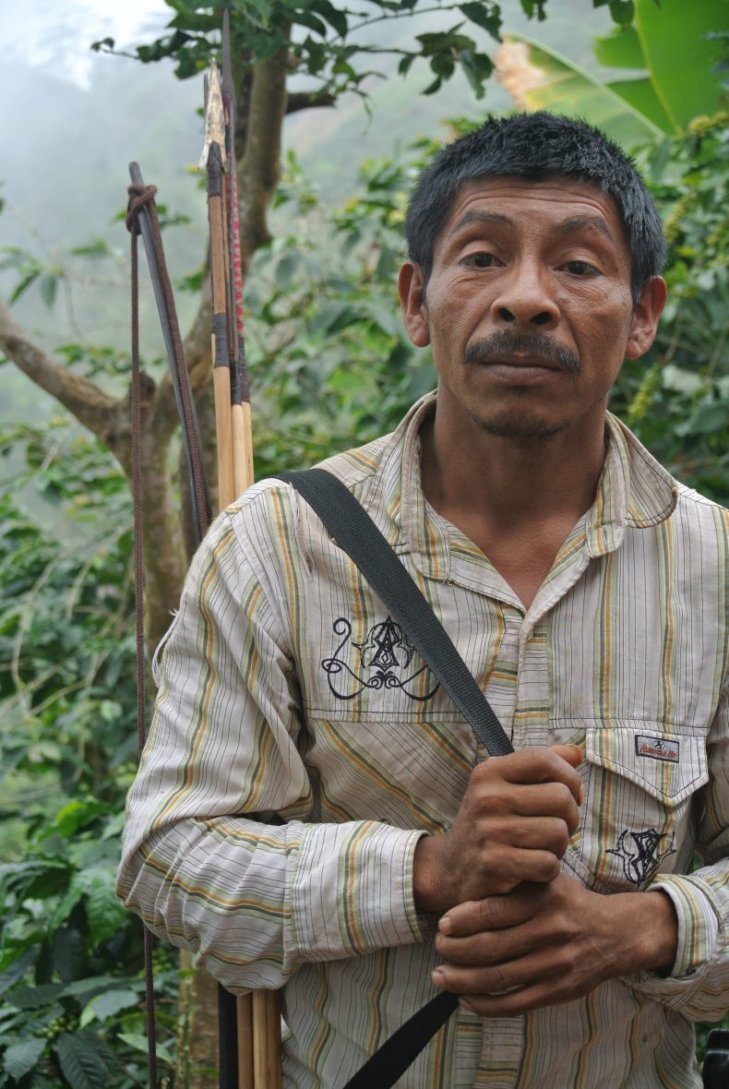
A Yukpa security guard, still armed with bow and arrow.
When the Colombian military entered the scene in the mid-1990s, the situation turned for the worst. Yukpa families could no longer move freely from house to house, leading to the systematic abandonment of more than 900 hectares of land. For years, military checkpoints restricted the flow of food between families. As if that wasn’t bad enough, paramilitary groups—who were often the same members of the military—came to the Yukpa villages at night to terrorize the community.
“They abused and humiliated us,” says Vence. “I think it was all in the hopes that we would open our mouths and say something that gave them the right to murder us.”
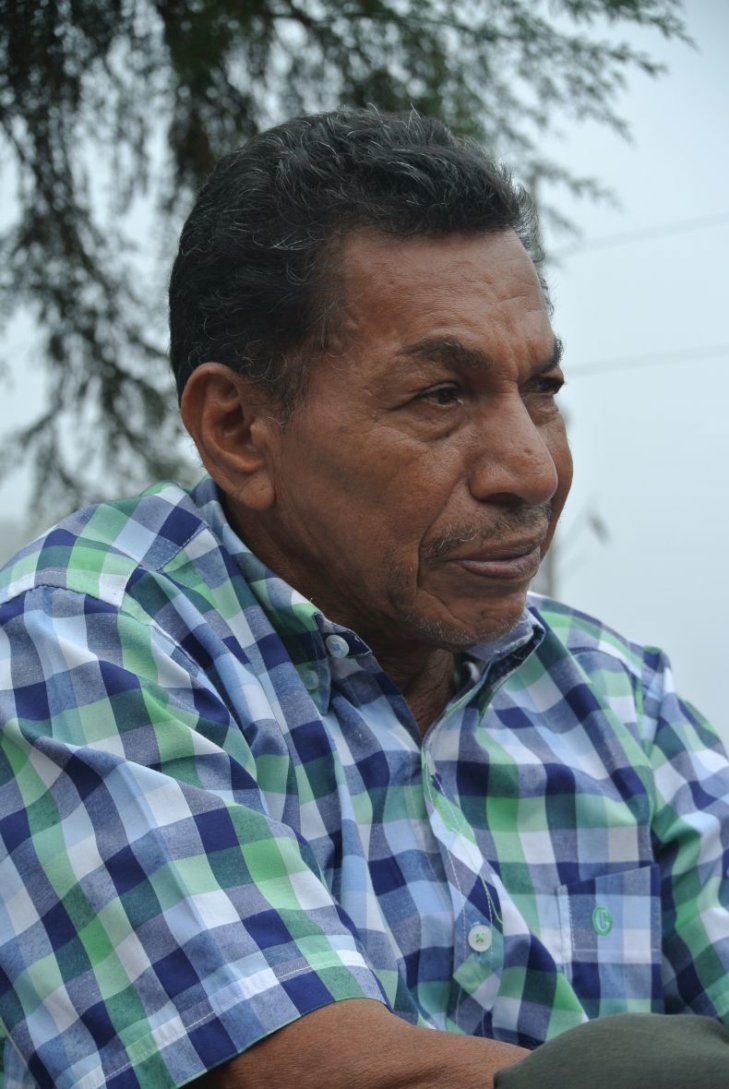
Andrés Vence, mayor and leader of the Yukpa community making the restitution claim.
DOCUMENTED HISTORY
In 2015, the regional Land Restitution Unit (LRU) in Cesar focused on “characterization studies,” an essential piece of evidentiary material that documents the background, victimization, and suffering of indigenous communities who wish to reclaim their land. Characterization is a critical step in substantiating an ethnic restitution claim. The USAID-funded Land and Rural Development Program* partnered with the LRU to expedite the process.
Over the course of six months, researchers visited the Yukpa, where they interviewed individual members and held focus groups. They also collected materials from the government, non-governmental organizations, academic texts, and the media. The end result was nearly 200 pages of history, mapping, experience, and evidence presenting how the armed conflict contributed to the decimation of the Yukpa’s culture, livelihood, and overall prosperity.
In addition to carrying out the characterization studies, USAID helped regional restitution offices improve coordination with partner members of the Victims Assistance and Comprehensive Reparations System and municipal officials.
“The partnership gave us operating capacity. Without this support, we would have taken another one or two years to get to this case,” says Jorge Chávez, Director of the Land Restitution Unit in Cesar.
The document will be filed as part of the Yukpa community’s land restitution claim, which will go before a restitution judge before the end of the year. By law, judges must issue a ruling within six months after a restitution claim is filed in the court. In Cesar, the Yukpa case will be the third ethnic restitution case to reach the courts, making the department an important player in the nationwide effort to heal the historic rift between the government and Indigenous Peoples.
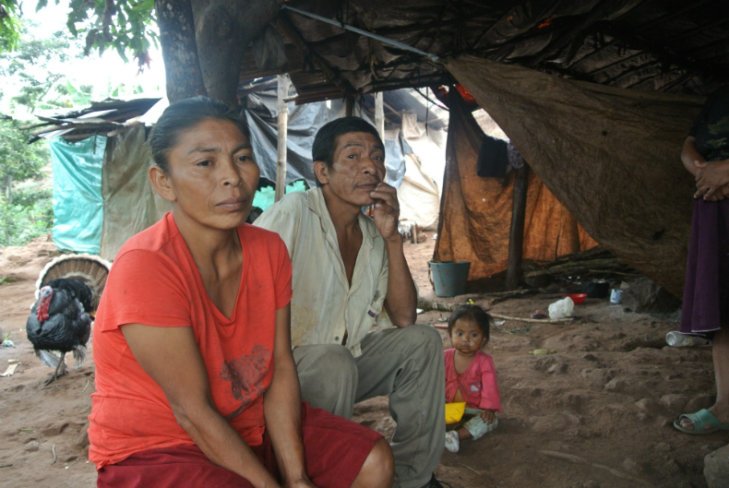
Colombia’s indigenous communities are often the country’s most vulnerable. Over the past five years, Colombian restitution judges have issued three ethnic restitution sentences, delivering over 124,000 hectares of land back to indigenous communities.
There are currently over 24 ethnic restitution cases in the characterization phase that stand to affect over 10,000 families in Colombia.
“All over the country, there are ethnic restitution cases reaching judges. The LRU is in its fifth year and these cases are becoming more and more important to resolve. This particular case is very important because the Yukpa are losing their cultural identity, and we recognize that,” according to Chávez.
In its five years, restitution judges have issued three ethnic restitution sentences, delivering over 124,000 hectares of land back to indigenous communities.
As the Yukpa wait on the judge’s ruling, the case’s progress has emboldened Vence to mobilize the community—including the older citizens known as Yimayjas—to transmit the collective memory and cultural skills like weaving mochilas, practicing spiritual rites, and crafting shields to fend off malignant spirits.
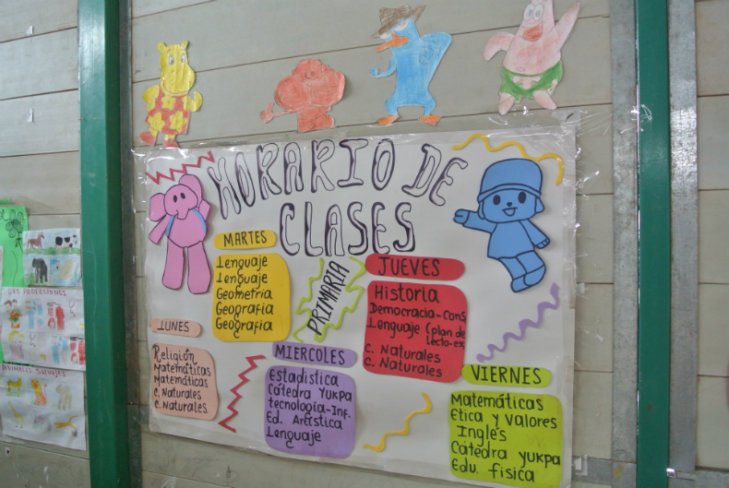
Every Wednesday and Friday, Yukpa children attend “Yukpa studies” at the only school in the resguardo.
A favorable ruling will be key to restoring Yukpa faith in the Colombian government. “We’ve put pressure on the government for many years to do this, so our hope is temporary. We watch television, and indigenous culture is never part of the conversation. Indigenous communities are the most vulnerable,” explains Vence.
* Nicholas Parkinson works for the Land and Rural Development Program.
Nicholas is an NGO writer currently based in Bogota, Colombia and working on a large land tenure program that sets out to strengthen government land administration agencies to better serve millions of victims displaced by the violence. Over the past six years, he has worked mainly on agriculture-focused projects in Ethiopia, Liberia, Uganda and Somalia, among others. He specializes in NGO documentation and teaches local writers how to create attention-grabbing stories for their NGOs. On his weblog you can find stories from his immigrant life, some thoughts on development aid, and a strong dose of rock climbing and adventure.
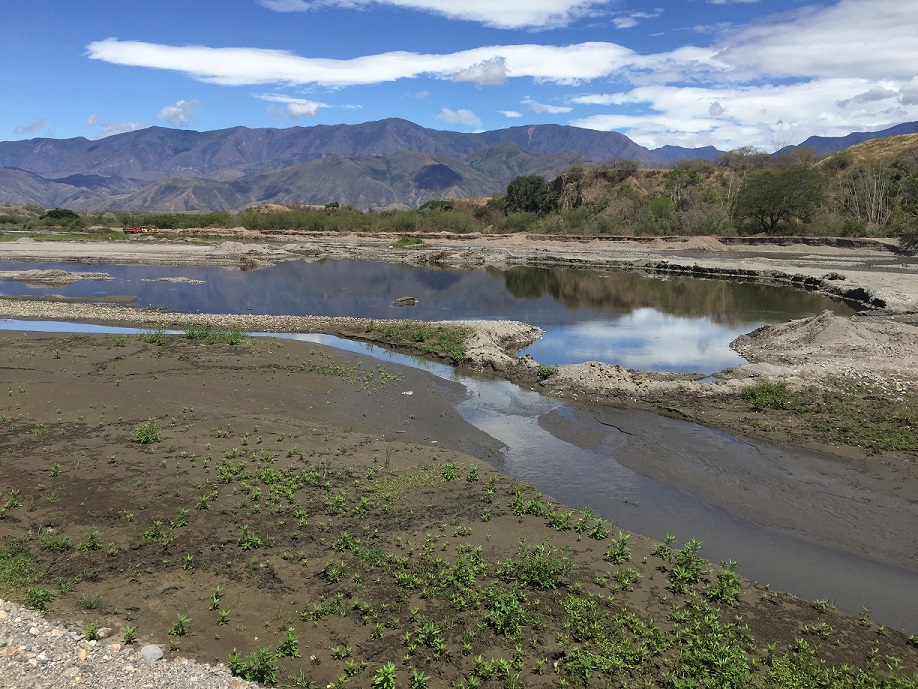
by Deep Green Resistance News Service | Sep 30, 2016 | Biodiversity & Habitat Destruction
Featured image: Afro-Colombian communities along the Patia River plundered by corporate privatization of water sources.
by Mary Louisa Cappelli
Colombia’s infrastructure development projects have led to privatized water grabbing and the marginalization and displacement of many indigenous and Afro-descendent communities living along the Patia River Corridor. Ingeneria de Vias SA (VIAS SA), a private civil engineering company specializing in the execution of urban infrastructure works and water supply networks appears to be directly responsible for a visible pattern of environmental racism in which sand and gravel mining has led to the critical deterioration of wetlands, ecosystems, and, more importantly sustainable livelihoods, along the Patia River.
According to local Galindez spokesman from the Pan Corridor Community Council, “VIAS SA originally received a permit in 2005, but failed to renew it when it expired in 2009.” Since 2009, trucks have been operating nonstop from 4 a.m. to 6 p.m. hauling away 14 square meters of material daily without governmental authorization. For 11 years, VIAS SA has been excavating sand and gravel to be used in the construction of roads and buildings. The excavation of the river has resulted in deterioration of water resources and bed degradation leading to the depletion of water tables, and the devastation of aquatic and riparian watersheds once inhabited by fish, waterfowl and other local species. Galindez spokesman explains, “I was born and I was raised here, and we have never seen this river look like a stream. And they want to continue drying it, just by extracting all these materials, they want to dry the river.”
The river has been a vital source of life for the socio-economic reproduction and traditional livelihoods of Afro-descendent communities. When neoliberal development projects emerged in the mid 1990s along with the sale of Empresa de Energía del Pacífico (ESPA) to an international consortium of Houston Industries, the needs of the local community were subordinated to privatized interests, which instigated unequal power relations and triggered an observable pattern of cultural disruption.
134 families from Galindez, 60 families from Palo Verde, 120 families from El Pilon and 15 families from Hamaca were dependent on the river for their sustainable livelihoods. In the name of development, habitats have been destroyed and families now suffer from food and water insecurity. According to Galindez Spokesman, “In the past, people didn’t have to buy plantains, corn, cassava, and fruits like papaya – but now because we can’t grow our food anymore, we have to work out how to get the money to buy the things we traditionally grew.”
While the Regional Autonomous Corporation of Cauca is supposed to give approval for development projects or projects with environmental impact, community members allege that Ingeneria de Vias SA has been operating outside Article 70, which states: “The State has the obligation to promote and foster access to the culture of all Colombians equally by means of permanent education and scientific, technical, artistic, and professional instruction at all stages of the process of creating the national identity;” Article 72, which states: “Ethnic groups settled in areas of archeological treasures have special rights over that cultural heritage, which rights must be regulated by law;” and Article 246, which provides that “the authorities of the indigenous peoples may exercise jurisdictional functions within their territories, in accordance with their own standards and procedures, provided they do not conflict with the Constitution and laws of the Republic.”
According to the community, they were not consulted about the excavation project and were denied a political voice about the development projects taking place on their ancestral rivers. While some community members are afraid to speak up for fear of physical reprisal, other community members strongly allege that the day-to-day excavation is being protected by paramilitaries who ensure a daily excavation quota. Justicia y Paz spokesperson observed the importance of considering the “role of the police and the role of the army” in the excavation processes. “Because a lot of the money that funds these institutions come from the United States. And in many cases the army and the police have violated the rights of the communities.”
The racialized dispossession of Afro-descendent peoples by privatized water grabbing projects testifies to the privileging of political and international elites, which has led to a trajectory of displacement, deterritorialization, and physical vulnerability. This type of racialized dispossession must be addressed in Colombia’s Post Accords Peace Process and most certainly taken into consideration in the US Congress’s final decision on Obama’s $450 million Peace Colombia Plan— a hefty financial package to support socio-political and environmental justice in the region.
In the words of Afro-Colombian spokesman, he wants the United States to be aware of the water grabbing, as he would like “to get back to a life of dignity.”
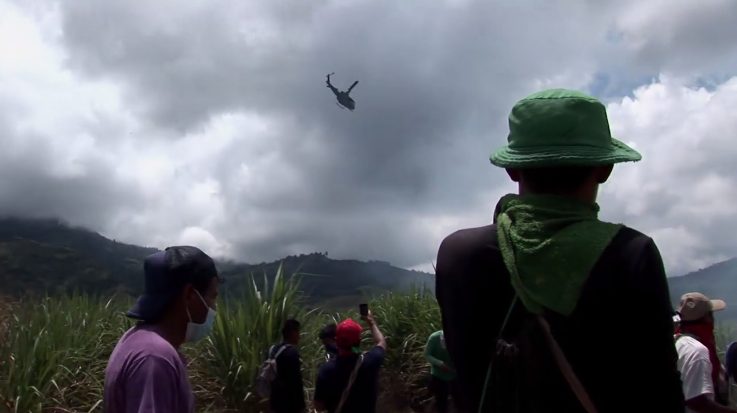
by Deep Green Resistance News Service | Sep 23, 2016 | Reclamation & Expropriation
Documentary film spotlights Nasa struggle to regain what was wrongfully taken
by Intercontinental Cry
Tired of waiting for lands promised by the Colombian government, in 2015, the Indigenous Nasa Peoples from southern Colombia decide to take direct action to reclaim lands that have been industrialized by one of the richest people in the country.
TIERRAS TOMADAS (Reclaiming Stolen Lands) documents the Nasa’s struggle to regain what was wrongfully taken, despite paramilitary threats, riot police and mercenaries.

by Deep Green Resistance News Service | Jul 19, 2016 | Repression at Home
Featured image: Adelina Gómez Gaviria, an anti-mining activist in the Colombian department of Cauca, was killed in 2013. Photo courtesy of Movimiento Nacional de Víctimas de Crímenes de Estado.
By Camilo Mejia Giraldo / Mongabay
- 534 political activists were assassinated across Colombia between 2011 and 2015, around 17 percent of them indigenous-rights or environmental activists.
- A report by the London-based NGO Justice for Colombia documented activist killings across the country between 2011 and 2015.
- On average two activists were killed per week over the five year period, according to the report.
- The figures are “at least” numbers that highlight areas of the country that require increased monitoring to obtain realistic figures; the actual number of killings is likely much higher, according to a Justice for Colombia representative.
- While many assassinations remain unsolved due to corruption or the state’s inability to carry out effective investigations, human-rights watchdogs say the majority is orchestrated by paramilitary groups.
In the oil-rich department of Casanare in eastern Colombia, Daniel Abril Fuentes was known as a campesino leader, defender of human rights, and constant critic of the oil interests he saw as a threat to his community and environment. Now, eight months after being shot dead outside a bakery in his native municipality of Trinidad, Abril’s name appears next to more than 500 others in a briefing documenting the assassinations of political activists in Colombia.
Published in April by the London-based NGO Justice for Colombia (JFC), the briefing lists 534 political activists who were assassinated across the country between 2011 and 2015. Of these, 83 were indigenous-rights activists and 10 were environmental activists — a total of more than 17 percent. On average two activists were killed per week over the five year period.
“These are horrifying figures, and seeing the names written out makes it more real. But this overall picture of political activists being killed [in Colombia] on a regular basis, unfortunately, isn’t a surprise to us, because it’s what we hear about every week,” Hasan Dodwell, JFC’s Campaigns Officer, told Mongabay.
The country is on the cusp of ending five decades of internal conflict between the state and leftist guerrillas, and violence between the two sides has steadily deescalated since peace talks began in 2012. However, contrary to this trend and the country’s declining homicide rate, data shows that murders of activists are actually increasing and are largely carried out by right-wing paramilitary groups, representatives of local organizations, including the human-rights monitor Programa Somos Defensores, told Mongabay.
Daniel Abril Fuentes, a human-rights and environmental activist in Colombia’s department of Casanare, was killed last November. Photo courtesy of Movimiento Nacional de Víctimas de Crímenes de Estado.Daniel Abril Fuentes, a human-rights and environmental activist in Colombia’s department of Casanare, was killed last November. Photo courtesy of Movimiento Nacional de Víctimas de Crímenes de Estado.
The JFC briefing collates information published by five different Colombian organizations, Programa Somos Defensores among them. According to Dodwell it represents just a snapshot of reality in which threats and attacks are carried out with impunity. The actual number of activists killed is likely to be much higher, he said.
As the briefing shows, Colombian activists are often targeted for their work against the expansion of natural-resource exploitation projects, according to Dodwell. An analysis this year by Irish NGO Front Line Defenders corroborates that assertion, finding that 41 percent of activist assassinations in Latin America are linked to the defense of the environment, land, or indigenous rights.
A more focused violence
The JFC briefing documents assassinations in 26 of Colombia’s 32 departments. Of these, Antioquia in the northwest had the highest number of activists killed, followed by Cauca, Valle del Cauca, and Nariño in the west, and then Cordoba in the northwest.
Carlos Guevara, communications coordinator for Programa Somos Defensores, told Mongabay that while these have been key zones in the internal conflict, the high number of attacks on activists is largely driven by economic interests. These include the cultivation of illicit crops and illegal gold mining — an industry the government regards as rivaling the drug trade in terms of revenue and the threat it poses.
Dodwell from JFC agreed, adding that the decades-long internal conflict has normalized violence in these areas and is now used as a façade for silencing activists.
“Generally, the conflict is being used as an excuse or platform for the murders of political activists. For example, peasant activists are targeted a lot as they are often defending their right to the land. And this is the concern: the peace process might be able to bring an end to the armed conflict but much, much more needs to be done to bring an end to the political violence,” he said.
Guevara described how the shift in violence across the country is creating an increasingly dangerous situation for activists.
“Civilian rights violations directly derived from the armed conflict have decreased drastically,” Guevara said. “But what we see now is that the violence is becoming a phenomenon that is more localized and focused. It is now being more effectively directed at community leaders.”
Much like Daniel Abril in Casanare, Adelina Gómez Gaviria was reportedly gunned down for her stance against illegal mining in the western department of Cauca. At 36, Gaviria was known as a charismatic community leader with a local land-rights group who had organized a Mining and Environmental Forum that was attended by more than 1,200 local campesinos and indigenous people. After receiving death threats by phone warning her to stop her activist work, Gaviria was shot dead and her 13-year-old son wounded in 2013.
According to Guevara, the departments of Valle del Cauca and Cauca are seeing a particularly strong intensification in violence as activists there push a human-rights agenda.
Adelina Gómez Gaviria, an anti-mining activist in the Colombian department of Cauca, was killed in 2013. Photo courtesy of Movimiento Nacional de Víctimas de Crímenes de Estado.Adelina Gómez Gaviria, an anti-mining activist in the Colombian department of Cauca, was killed in 2013. Photo courtesy of Movimiento Nacional de Víctimas de Crímenes de Estado.
“These regions contribute the most to these figures, both in attacks and deaths of activists, because they have become laboratories for peace. Civil society there is talking more and more about peace in zones where they face real enemies,” he said.
Continuing influence of paramilitary groups
While many assassinations remain unsolved due to corruption or the state’s inability to carry out effective investigations, Guevara asserted that the majority is orchestrated by paramilitary groups.
Although these groups officially laid down their arms under an agreement with the government in 2006, many local rights groups highlight their ongoing activity. However, the government does not officially recognize their existence. Instead it has relabeled them as BaCrim (for bandas criminales; “criminal groups” in English) so as not to undermine the 2006 demobilization process.
“Paramilitary groups, neo-paramilitary groups, BaCrim, or whatever you want to call them, are the biggest threat to activists. In our [recent] report we identify that they are responsible for 63 percent of attacks this year alone. Last year they also had a high percentage; they almost always have the highest percentage,” said Guevara.
Yet the state’s reluctance to recognize the existence of these groups makes it difficult to focus attention on them and protect activists, he added.
“There are far right sectors in the country that are hiding under the facade of BaCrim, and they have been doing so for years, such as the Aguilas Negras,” he said, referring to a paramilitary group active in drug trafficking. “But for the state, the Aguilas Negras do not exist. So I can’t explain how in the last five years they’ve threatened more than 800 activists.”
The quarterly report Guevara mentioned analyzed 113 reported aggressions against human rights defenders in Colombia between January and March of this year. It documents a total of 19 activists assassinated during that period, two of them environmental activists. The report notes that although the number of aggressions decreased in comparison to the same period last year, the number of activists killed remained the same.
Partially republished with permission of Mongabay. Read the full article, Heavy toll for green and indigenous activists among Colombian killings
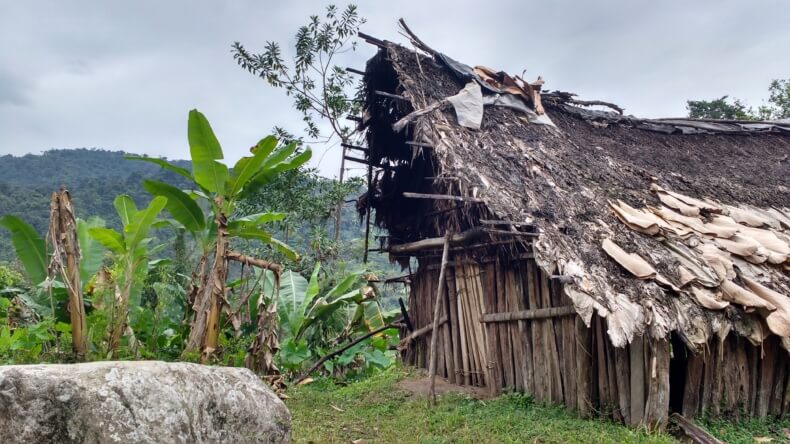
by Deep Green Resistance News Service | May 15, 2016 | Colonialism & Conquest, Indigenous Autonomy, The Solution: Resistance
By Jake Ling / Intercontinental Cry
Featured image: Inside the United U’wa Resguardo on the cloud forests along the Colombia-Venezuela border. Photo: Jake Ling
This is the final installment of “The Guardians of Mother Earth,” Intercontinental Cry’s four-part series examining the Indigenous U’wa struggle for peace in Colombia.
The vast wetland savanna called Los Llanos stretches thousands of miles into Venezuela but it begins on the U’wa’s traditional territory at the base of the foothills below the cloud forests and paramos surrounding the sacred mountain Zizuma. For the last few years the worst fears of local environmentalists fighting on this forgotten frontline of climate change have come true: excessive exploitation of (though maybe that’s redundant since the categories already give a way to find stories about indigenous issuespetroleum in the Casanare region on the eastern border of the U’wa resguardo helped cause the desertification of large tracts of land in the swamps and grasslands across the province. An estimated 20,000 animals have died of thirst as traditional water holes evaporated and cracked under the strain of complete ecosystem collapse. Now, the only sign of life in places that once teemed with native species such as capybaras, deer, foxes, fish, turtles and reptiles, is the occasional vulture.
As Highway 66 snakes around the base of the mountain range, it passes several fortified military outposts guarding bridges and monitoring the flow of traffic towards Cubará in the Boyacá Frontier District. These bridges that once conquered the massive flows streaming down from the paramos above the clouds in the west now overlook small streams of water between riverbed boulders as Colombia plunges into a severe drought.

One of the many rivers that flow from the mountains in U’wa territory that are now almost dry as Colombia plunges into a severe drought. Photo: Jake Ling
Seventeen years ago, in the final week of April, 1999, an international event was organized known as U’wa Solidarity Week. It was the early days of climate change awareness when the world was just beginning to understand Global Warming and its potentially devastating effects on the planet. The international campaign against the oil multinational Occidental Petroleum had hit critical-mass after the kidnapping and assassination of Terry Freitas, the 24 year old co-founder of the U’wa Defense Working Group, and the two renowned native american activists Lahe’enda’e Gay and Ingrid Washinawatok, by FARC guerillas in eastern Colombia. Protests against Occidental Petroleum in support of the U’wa were being held in eight cities across the United States as well as in London, Hamburg, Lima and Nairobi. Meanwhile, in the background, the burgeoning power of a very young cyber-network called the Internet had created a space for the remote U’wa nation, heralding a new age of activism that facilitated vital connections between grassroots indigenous movements and environmental activists abroad.
Berito traveled to Los Angeles with another U’wa leader, Mr. Nuniwa, where the two men were received by organizations such as Rainforest Action Network, Project Underground, Amazon Watch and half a dozen other groups that planned to converge on Occidental Petroleum’s Annual Shareholder Meeting on friday, April 30th, 17 years ago.
At a dinner before the shareholder meeting the two U’wa leaders held hands to say grace with the two-dozen American activists around a feast of primarily vegan salads and vegetarian stews for the activists and dishes of meat for the chiefs. With the assassination of the American activists still painfully fresh in the minds of the the protest movement, the U’wa leaders proclaimed that after his death Terry Freitas had visited the dreams of the Werjayá, the shamanic healers of the U’wa in charge of communicating with the superior powers that flow through nature. In the dream Freitas was clutching a white snail shell, a symbol of spiritual purity and peacemaking, and the Werjayá declared the apparition of a god. The two U’wa leaders Berito and Nuniwa invoked their ancestors at the dinner table and summoned the spirit of Terence Freitas.
The following Wednesday, halfway through U’wa Solidarity Week, about 200 or so people marched from the University of California, where Freitas had studied, to Occidental’s headquarters a mile away. Many of the protestors were led away by the police.
“Why don’t they just finish us off for good, so we don’t have to struggle?” Berito told the Wall Street Journal, while his colleague Mr. Nuniwa expressed surprise that their march lasted as long as it did, considering the extremely aggressive tendencies of Colombia’s riot police.
The movement placed an advertisement in the New York Times — endorsed by Sierra Club, the National Wildlife Federation, Friends of the Earth, Oilwatch, Oxfam-America, Earthjustice Legal Defense Fund, the Center for International Environmental Law and others — warning Occidental shareholders of the political and environmental risks of the mining project: “U’wa territory will not be spared the oil wars raging in the nearby Arauca area, where a violent attack on Oxy’s pipeline occurs every eight days. Meanwhile, those familiar with U’wa culture warn that their suicide pact must be taken seriously. U’wa oral histories recount an event four hundred years ago, when an U’wa band leaped from a cliff rather than submit to the Conquistadors.”
As protestors picketed the building hosting the shareholder meeting, inside Occidental’s chairman and CEO Ray Irani, seethed as the U’wa leader Berito lectured him for 45 minutes. Berito sang a sacred song in the U’wa tongue which he told protestors the previous night at dinner would be about “Mother Ocean and her breath, the wind, which sweeps up our words to the gods.” The 1,000 or so shareholders in attendance applauded the U’wa leader. Chairman Irani’s response was to declare: “The fact of the matter is your problems should be discussed with the Colombian government, not here… It doesn’t matter what Occidental does or doesn’t do.”

U’wa leader Berito Cobaria battles Oxy CEO Ray Irani at the oil multinationals Annual Shareholder Meeting 17 years ago. Drawing by Bolivian artist Pablo Ruiz
The Sinsinawa Dominican nuns, who held 100 Oxy shares, proposed that the oil multinational hire an independent firm to analyze the potential impact on the company’s stock if the U’wa people’s pledge to commit mass-suicide was fullfilled. The proposal, which Terry Freitas had helped draft, went on to win approval from 13 percent of Oxy shareholders, totaling over 40,000,000 shares, exceeding the expectations of the activists and forcing those opposed to consider the consequences.
After the meeting, Chairman Irani and the other directors made a stealthy exit out a side door where their limousines waited on the opposite side of the building to the protestors. Irani told the Wall Street Journal, “The U’wa use these activists very effectively.” Meanwhile Oxy Vice President Lawrence Meriage complained that the campaign was a concoction of certain activists up in the Bay Area and suggested the U’wa were being manipulated by U.S. environmentalists dead set against oil exploration, as well as the Colombian guerrillas that his company helped finance since the 1980’s. “We feel as a company that we’re caught in the middle,” said Mr. Meriage.
“We demand an announcement by Occidental that it is canceling its project on our ancestral land,” said Berito, “There is nothing else left for the company to do.”
As outrage over Occidental Petroleum’s behaviour in Colombia continued to grow, the oil multinational pushed ahead with their plans to exploit the petroleum block on U’wa territory. The next year, in February 2000, several hundred indigenous people and thousands of Colombians mobilized to block roads and prevent heavy machinery from arriving at the drilling site. The demonstration ended in tragedy as Colombian security forces violently dispersed the protestors with beatings and tear-gas leading to the tragic death of three U’wa children who drowned in the river while trying to flee government troops.
Occidental Petroleum pulled out of petroleum block on U’wa territory in May 2002, 10 years after the U’wa first threatened to commit mass suicide in protest. That same month, as senior members of the U.S. government publicly rallied against the FARC for the “terrorist murder” of Freitas, Gay and Washinawatok, President George H.W. Bush proposed $98 million in military aid to the Colombian government to protect Occidental Petroleum’s Caño-Limon-Covenas oil pipeline.
“We are dismayed to see the Administration’s cynical and exploitative use of Terence’s murder to justify further U.S. military aid to the Colombian armed forces,” friends and family of Freitas stated in response to the President’s proposal. “Employing Terence’s death as a means to continue perpetuating violence in Colombia grossly contradicts everything Terence believed in.”
“This isn’t about corporate welfare, it’s not about protecting Oxy,” a State Department official said. “It’s a security argument, not a U.S. economic interests argument.” The $4 million dollars that Occidental spent lobbying the U.S. government, however, certainly paid off for the company.
As the U’wa struggle slowly faded from the consciousness of the international community, the oil wars in eastern Colombia continued to escalate with the $98 million injection of U.S. military aid. Despite the U.S. State Department designating the AUC – the United Self-Defense Forces of Colombia – as a terrorist group in 2001, these paramilitary death squads formed the vanguard of the Colombian Army’s surge into the ELN stronghold of Arauca province, along the Caño-Limon-Covenas pipeline.
The Colombian army, meanwhile, received additional funds totaling billions of dollars coinciding with the kidnapping and execution of thousands of Colombian civilians, whose bodies were then dressed up in guerrilla uniforms to artificially inflate body counts, a crime known as the “scandal of false positive.” Between 2000 and 2010 the Colombian military kidnapped and executed 164 civilians in Arauca, 122 in Boyaca, 301 in Norte de Santander, 209 in Casanare, the four provinces bordering the U’wa Nation’s territory.
Occidental Petroleum’s direct financial and logistical support to the Colombian military included a specialized meeting room inside the Oxy-fortified compound for the 18th Brigade that operates in Arauca and the Boyacá Fronteir District of Cubara with the mandate of protecting the Cano-Limon-Covenas. Commander César Oswaldo Morales of the military’s 18th Brigade was imprisoned in 2012 for kidnapping and executing civilians years earlier in northern Colombia.
In an effort to deescalate the war, an agreement between the government and right-wing paramilitaries saw the AUC begin to lay down arms in 2003. The demobilization, which is widely viewed as a failure, led to the rise of neo-paramilitary groups called BACRIM that continue to threaten and target the civilian population and indigenous people who protest the contamination of their lands and waters by oil operations in the region.
In 2006, the BACRIM inflicted a reign of terror in the Catacumbo region of Norte de Santander, displacing 8,000 civilians over a few months to the north of the U’wa resguardo’s border. It was the same year that Colombia’s Interior Ministry cleared the way for state-run Ecopetrol to begin new explorations in the U’wa territory on behalf of the Spanish oil giant RepSol, as well as on another site inside U’wa territory to the west of the Gibraltar drilling site.
There is not a pipeline on the planet that has been bombed as many times as the Caño-Limo-Covenas. It is an engineering marvel that reaches deep beneath the war-torn province of Arauca and stretches 780 kms (480 miles) across the country to the Caribbean and the effluent discharged into the rivers and lakes that surround the oil well make them no longer fit for human consumption. The several hundred bombings that have ruptured the length and breadth of the pipeline have also polluted 1,625 miles of rivers with thick cancerous crude, leaving a devastating legacy for the local indigenous and rural populations.

The major river in the region, the Arauca that separates Colombia and Venezuela, is experiencing reduced flows due to the drought and many of its tributaries drying up. It has also been affected by oil spills after bombings of the Caño-limon-covenas. Photo: Jake Ling
This particular environmental disaster is a symptom of a larger problem in Colombia with roots that reach deeper into a much darker cause. Across the country indigenous men, women and children from tribal nations both large and small are being murdered and displaced to make way for mega-mining projects. In the Sierra Nevada mountains, the Kankuamo Indigenous Peoples were the victim of twin arson attacks on separate religious temples two days after they canceled consultations with the government to oppose 400 mining projects in the region that will affect 100,000 indigenous people. In the northern state of La Guajira, the multinational el Cerrajon mine is diverting 17 million liters of river water daily during a severe drought that has decimated rural people’s livestock and responsible for indigenous Wayuu children dying of thirst.
For the Wounaan Peoples on the pacific coast, 63 families have been displaced in the past year as petroleum exploration takes place on their ancestral lands. “We know that the peace process will open the way for megaprojects that bring international investments into our territory,” said one member of the Wounaan, “therefore we know that true peace will not come. For Indigenous Peoples the violence will not end with the peace process.”
The ability of the Colombian government to hold multinationals to account for crimes against the civilian population, Indigenous Peoples and the environment is limited while the country attempts to rebuild its crippled economy and frail state institutions after half a century of war. Despite this, predatory multinationals are currently suing the Colombian government for billions of dollars whenever it attempts to protect the environment: such as the $16.5 billion lawsuit that U.S. Tobie Mining and Energy launched against the government when it declared an area in the Amazon rainforest a National Park, where the U.S. company owns a mining concession; or the lawsuits launched by multinationals protesting the new law banning mining in the country’s paramos.
Seventeen years after her murder, Washinawatok’s words in her essay “On Working Towards Peace” now seem increasingly prophetic: “The roots of war and violence go deep, into the Earth herself. As an indigenous woman, I wish to simply state that until we make peace with Earth, there will be no peace in the human community.”

Written on the side of an U’wa school are the words: “nature is wise and as much as man tries he cannot overcome her.” Photo: Jake Ling
“In the late 90’s the U’wa struggle against Occidental Petroleum resonated with progressive social movements that were fighting corporate domination, the multilateral financial institutions like the World Bank and free trade agreements like NAFTA,” said Andrew Miller, Director of Advocacy at Amazon Watch. “The core U’wa messages have not changed, and once again we see synergies within the global conversations about climate change and the growing movement to keep fossil fuels in the ground.”
It was the multiple bomb attacks on the Caño-Limon-Covenas inside U’wa territory in March and April 2014, which not only showcased the indigenous nation’s vulnerability but also its strength. The subsequent 40-day protest in which petroleum engineers were prevented from accessing the bomb-site to fix the ruptured pipe cost the Colombian government $130 million dollars. The concessions that the state proceeded to make to the U’wa in exchange for stopping the protest included the dismantling of the gas exploration project in Magallanes; other points in the agreement have since been ignored.
A year later, the pipeline was bombed again on U’wa territory, contaminating the Cubogón and Arauca rivers and creating an environmental emergency that left the entire state of Arauca downstream without water. The Colombian government had still not fulfilled its side of the deal leading 40 organizations to sign an open letter to President Santos reminding him of the agreement.
At the end of March, 2016, two weeks after another twin-bomb attack on the Caño-Limon-Covenas, and only days after the U’wa mobilization surrounding the Cocuy National Park received the threatening photograph of the armed-sheep, Amazon Watch issued its highest red-alert to warn its network of concerned global citizens of the dangers facing the protestors. The International Urgent Action has so far received 5,000 signatures from people around the world supporting the U’wa’s demand of a direct dialogue with Colombia’s former Minister of Environment.
The requests were ignored; however, just two weeks ago, on April 25th, President Santos replaced the minister with Luis Gilberto Murillo, the former Governor of Choco province, who is himself a victim of the war after being kidnapped by paramilitaries. The new Minister for Environment is now presented with the opportunity to mend relations with the U’wa Peoples by handing over the administration of the Cocuy National Park, an act that would protect its precious ecosystems while providing a source of income to the communities via sustainable and responsible tourism. The government’s obligations under Colombian law, however, do not end there. The U’wa still urgently need access to better health-care facilities and clean drinking water to prevent the spread of tuberculosis and dysentery — two basic human rights that the international community can pressure President Santos to fulfill.
As the U’wa leader Berito recovers from tuberculosis in his wooden shack in the cloud forests on the eastern border of the United U’wa Resguardo, he is content at having officially changed his name late last year. The indigenous leader passed IC an original copy of his signed and stamped identification papers, issued to him a year earlier when he traveled to Bogotá to change his name from Roberto Cobaria, the name arbitrarily placed on him by Catholic missionaries. Now, the Colombian government must recognize him by the same name his people call him – Berito KuwarU’wa KuwarU’wa – the wise and powerful Werjayá whose life work has been to guide the people who know how to think and speak through the most violent and longest running armed conflict on the South American continent.
In the coming weeks or months when the FARC and Colombian government are expected to finalize a historic peace agreement, the war will not be over for the U’wa people. The Paramilitaries eventually dispersed, more BACRIM may be imprisoned, most of the FARC will probably demobilize, the ELN may lay down arms, the state military might be disciplined with court-martials, but the Colombian government will never give up its relentless thirst for the sacred blood of Mother Earth underneath the ancestral lands of the U’wa. Once again the U’wa are cornered on all sides with their backs against a cliff, but the question remains if the indigenous group will jump or if they will be pushed.

Berito discussing the threat of oil drilling at Amazon Watch’s 2010 Annual Luncheon. Photo: Amazon Watch
“The U’wa people are reaching out at a national and international level to ask for the unconditional assistance to our struggle that dates back many years,” Berito announced in 2014, before he became sick. “We refuse to be silent and we are going to mobilize ourselves and once again engage in protest actions against the extraction of oil which will damage our Mother Earth.”
Jake Ling is the founder of www.ecuadorecovolunteer.org and has worked with indigenous communities for several years on conservation projects in the Andes and Amazon. He writes for Colombia Reports and IC and he tweets at @chekhovdispatch










